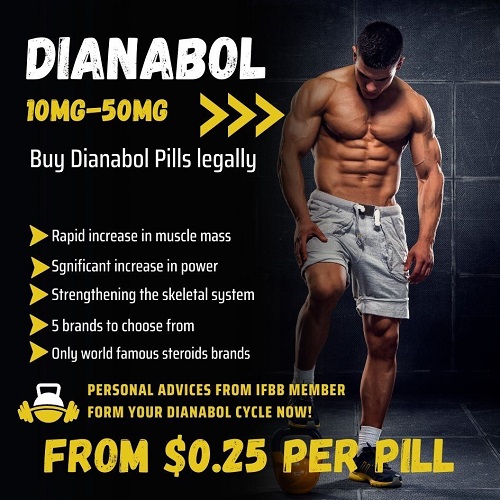A Comprehensive Comparison: Dianabol vs Tren
Are you a fitness enthusiast looking to enhance your performance and achieve your body goals? In the world of bodybuilding and athletic performance, the use of anabolic steroids has become a prevalent topic of discussion. Among the most popular and widely debated choices are Dianabol and Trenbolone (commonly known as Tren). These two compounds have gained fame for their ability to significantly enhance strength, muscle mass, and overall physical performance.
Discounted Dianabol from legal anabolic steroids provider
But which one is right for you? In this comprehensive comparison, we’ll delve into the world of Dianabol and Tren, exploring their similarities, differences, benefits, and potential side effects. So, whether you’re an aspiring bodybuilder or a seasoned athlete, join us on this journey as we uncover the secrets behind these powerful compounds and help you make an informed decision for your fitness journey.
Table of Contents
The Origins and Background of Dianabol and Tren
The world of fitness and bodybuilding has always been driven by the pursuit of excellence and the desire to surpass one’s physical limits. To achieve these goals, individuals have turned to various methods, including the use of anabolic steroids. Among the many options available, two steroids have emerged as popular choices for those seeking substantial gains in muscle mass and strength: Dianabol and Trenbolone. These compounds have captured the attention of athletes and bodybuilders worldwide, but understanding their origins and backgrounds is crucial in making informed decisions regarding their use.
Dianabol:
Dianabol, also known as Methandrostenolone, was first developed in the 1950s by Dr. John Ziegler, an American physician. Its creation was a response to the growing desire to enhance athletic performance and gain a competitive edge. Initially, Dianabol was designed for use by the United States Olympic weightlifting team to counter the performance-enhancing methods used by Soviet athletes. This anabolic steroid quickly gained popularity within the bodybuilding community due to its potent muscle-building properties.
Trenbolone:
Trenbolone, often referred to as Tren, originated in the late 1960s as a veterinary medication for livestock. It was primarily used to promote muscle growth and increase feed efficiency in cattle. Over time, its remarkable anabolic effects attracted the attention of the bodybuilding community. As a result, pharmaceutical companies started producing Trenbolone for human use in the form of various esters, such as Trenbolone Acetate and Trenbolone Enanthate.

Mechanisms of Action: How Dianabol and Tren Work in the Body
Dianabol exerts its effects through its active ingredient, Methandrostenolone. When ingested, it enters the bloodstream and binds to androgen receptors in the body, including those found in skeletal muscle tissue. This binding process triggers a series of molecular events that promote protein synthesis, leading to increased nitrogen retention within the muscles. Consequently, Dianabol enhances the body’s ability to build and repair muscle tissue, resulting in significant gains in muscle mass and strength.
Additionally, Dianabol has an impact on glycogenolysis, the process by which glycogen (stored glucose) is broken down and converted into usable energy. By increasing glycogenolysis, Dianabol enhances energy availability during intense workouts, allowing users to train at higher intensities for longer durations. This attribute contributes to the steroid’s reputation for dianabol cycle boosting performance and aiding in the recovery process.
On the other hand, Trenbolone operates through its active ingredient, Trenbolone acetate or Trenbolone enanthate. Like Dianabol, Trenbolone binds to androgen receptors, primarily in muscle tissue. This binding stimulates a variety of anabolic processes, including increased protein synthesis and nitrogen retention. The heightened protein synthesis enables accelerated muscle growth and repair, leading to notable gains in muscle mass and strength.
What sets Trenbolone apart is its ability to promote the production of Insulin-Like Growth Factor 1 (IGF-1), a hormone crucial for muscle growth and recovery. Trenbolone also inhibits the production of cortisol, a catabolic hormone that can break down muscle tissue. By reducing cortisol levels, Trenbolone helps preserve muscle mass during intense training, further enhancing the muscle-building process.
Read also about Winstrol sale
Comparing the Muscle-Building Potential of Dianabol and Tren
When comparing the muscle-building potential of Dianabol and Trenbolone, it’s essential to understand how these steroids can impact your body’s growth and development. The following table provides a side-by-side comparison of Dianabol and Trenbolone in terms of their muscle-building capabilities. From the significant gains in muscle mass to the notable increases in strength, this table highlights key aspects of these steroids’ effects on protein synthesis, nitrogen retention, glycogenolysis, IGF-1 production, and cortisol inhibition.
Comparing the Muscle-Building Potential of Dianabol and Tren
| Dianabol | Trenbolone | |
|---|---|---|
| Muscle Mass | Significant gains | Substantial gains |
| Strength | Marked increase | Considerable boost |
| Protein Synthesis | Enhanced | Heightened |
| Nitrogen Retention | Increased | Elevated |
| Glycogenolysis | Improved energy availability | Enhanced energy output |
| IGF-1 Production | N/A | Stimulated |
| Cortisol Inhibition | N/A | Reduced |
Strength Gains: Dianabol vs Tren – Which Reigns Supreme?
When it comes to strength gains, Dianabol and Trenbolone are two formidable contenders in the world of performance-enhancing substances. The following table presents a head-to-head comparison of Dianabol and Trenbolone in terms of their ability to enhance strength. From marked increases in strength to heightened power output and enhanced endurance, this table sheds light on the potential impact of these steroids on your physical performance. Additionally, it explores factors such as recovery, training intensity, and the potential to break through performance plateaus.
| Dianabol | Trenbolone | |
|---|---|---|
| Strength Enhancement | Marked increase | Considerable boost |
| Power Output | Improved | Enhanced |
| Endurance | Increase | Enhanced |
| Recovery | Accelerated | Improved |
| Training Intensity | Heightened | Elevated |
| Performance Plateau | Can break through | Potential to surpass |
Dosage, Cycle Length, and Administration: Best Practices for Dianabol and Tren
When it comes to using anabolic steroids like Dianabol and Trenbolone, understanding proper dosage, cycle length, and administration protocols is crucial to maximize benefits and minimize potential risks. Each compound has its own recommended guidelines and considerations. Let’s delve into the best practices for using Dianabol and Trenbolone to help you make informed decisions.
- Dosage: The recommended dosage for Dianabol typically ranges from 20 to 50 milligrams (mg) per day. However, beginners are advised to start with lower doses to assess their tolerance and response. Trenbolone dosages vary depending on the ester used, but generally range from 200 to 400 mg per week. Again, beginners should start at the lower end of the dosage spectrum to gauge their body’s reaction.
- Cycle Length: Cycle length refers to the duration of steroid use before taking a break. Dianabol cycles usually last between 4 to 6 weeks due to its hepatotoxicity (potential liver toxicity). Trenbolone cycles are generally longer, spanning 8 to 12 weeks, considering its longer ester forms. However, it’s essential to remember that longer cycles may increase the risk of adverse effects.
- Administration: Dianabol is usually taken orally in tablet form, making it convenient for users. It has a relatively short half-life, requiring multiple daily dosages to maintain stable blood levels. Trenbolone is available in various forms, including injections and oral preparations, with the injectable forms being the most common. Injectable Trenbolone has a longer half-life, allowing for less frequent administration, usually 2 to 3 times per week.
- Supportive Measures: To mitigate potential side effects and maintain overall health during a cycle, it is crucial to incorporate supportive measures. This includes monitoring blood pressure, cholesterol levels, liver health, and ensuring proper post-cycle therapy (PCT) to restore natural hormone production.
It is important to note that the dosages, cycle lengths, and administration protocols mentioned above are general guidelines. Individual responses can vary, and it is advisable to consult with a healthcare professional or an experienced steroid user before starting a cycle. They can provide personalized recommendations based on your goals, experience, and overall health.
Remember, the misuse or abuse of anabolic steroids can lead to severe health complications. Adhering to proper dosages, cycle lengths, and administration practices is essential for maximizing benefits while minimizing potential risks associated with Dianabol and Trenbolone use.
Buy real quality Dianabol from trusted source.
The Role of Dianabol and Tren in Cutting and Bulking Cycles
Dianabol and Trenbolone are often used in both cutting and bulking cycles, but their roles and effects can differ significantly depending on the specific goals of the user. Understanding how these compounds can be utilized in each phase is crucial for achieving desired results.
Bulking Cycles:
Bulking cycles aim to maximize muscle mass and overall size. Dianabol is renowned for its ability to promote rapid muscle growth and strength gains, making it a popular choice during bulking phases. It enhances protein synthesis, nitrogen retention, and glycogenolysis, resulting in increased muscle mass and improved performance. When combined with a high-calorie diet and intense weightlifting, Dianabol can help users achieve substantial gains in muscle size and strength.
Trenbolone, on the other hand, is a potent steroid with significant anabolic and androgenic effects. It promotes muscle growth, enhances protein synthesis, and increases nitrogen retention. Trenbolone’s ability to prevent muscle breakdown (anti-catabolic effect) makes it valuable during bulking cycles. It also provides a hard and dry appearance to the muscles, giving users a lean and defined look even while in a calorie surplus.
Cutting Cycles:
Cutting cycles focus on reducing body fat while preserving lean muscle mass. Dianabol is not typically used in cutting phases due to its tendency to cause water retention and promote weight gain, which can hinder efforts to achieve a lean physique. However, some individuals may incorporate low doses of Dianabol at the beginning of a cutting cycle to maintain muscle mass while initiating fat loss.
Trenbolone, on the other hand, is highly regarded for its effectiveness in cutting cycles. It promotes fat loss by increasing metabolic rate and enhancing the body’s ability to utilize stored fat as an energy source. Trenbolone also helps preserve lean muscle mass during calorie restriction, allowing users to maintain strength and a sculpted physique. Additionally, it provides a hard and vascular appearance, making it a popular choice among bodybuilders preparing for competitions.
It is important to note that regardless of the cycle phase, proper diet and training are essential for achieving desired results. Whether in a bulking or cutting cycle, users should focus on a balanced diet, appropriate caloric intake, and tailored workout routines to maximize the benefits of Dianabol and Trenbolone.
As with any steroid use, it is crucial to prioritize health and safety. Adhering to recommended dosages, cycle lengths, and incorporating appropriate support measures are vital to minimize potential side effects and ensure a positive experience with Dianabol and Trenbolone during both cutting and bulking cycles.
Conclusion
While Dianabol excels in promoting rapid muscle growth and strength gains, Trenbolone offers substantial strength enhancements and the ability to surpass performance plateaus. Understanding their roles in cutting and bulking cycles is vital for tailoring their usage to specific fitness goals. However, it is crucial to approach the use of these steroids with caution, adhering to recommended dosages, cycle lengths, and supportive measures to mitigate potential risks and side effects.
It is important to remember that the use of anabolic steroids should always be approached responsibly and within the bounds of the law. Consulting with healthcare professionals or experienced individuals is highly recommended to ensure a safe and informed approach to performance enhancement. Ultimately, the decision to use Dianabol, Trenbolone, or any other steroid should be made with careful consideration of personal goals, potential risks, and adherence to ethical and legal standards in the pursuit of optimal fitness and performance.
Frequently Asked Questions
Q: What are the main differences between Dianabol and Trenbolone?
Dianabol and Trenbolone differ in their mechanisms of action and effects on the body. Dianabol is known for its rapid muscle growth and strength gains, while Trenbolone offers significant strength enhancements and the potential to break through performance plateaus.
Q: Which steroid is more suitable for cutting cycles?
Trenbolone is generally considered more suitable for cutting cycles due to its ability to promote fat loss, preserve lean muscle mass, and provide a hard and defined appearance.
Q: Can Dianabol be used for strength gains during a cutting phase?
Dianabol is not typically used during cutting phases due to its tendency to cause water retention and weight gain, which can hinder efforts to achieve a lean physique. However, low doses of Dianabol can be used to maintain muscle mass while initiating fat loss.
Q: What are the potential side effects of Dianabol and Trenbolone?
Common side effects of Dianabol include water retention, high blood pressure, liver strain, and potential androgenic effects. Trenbolone’s potential side effects include cardiovascular strain, negative impact on cholesterol levels, and androgenic effects.




